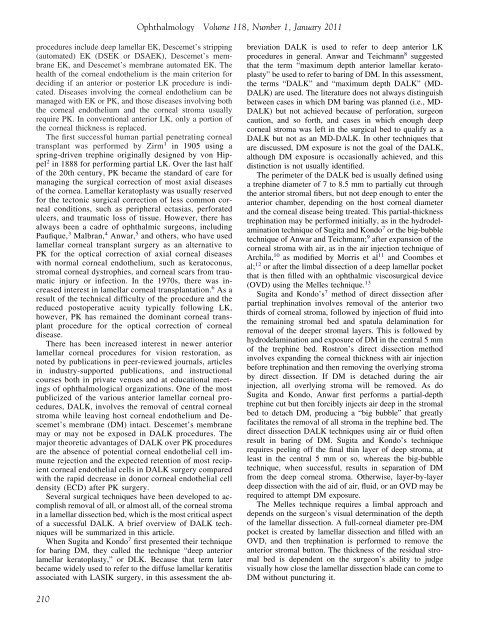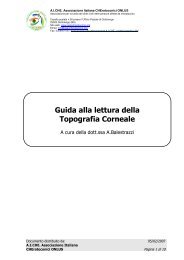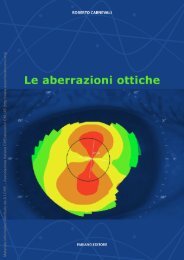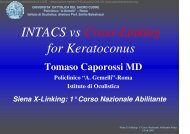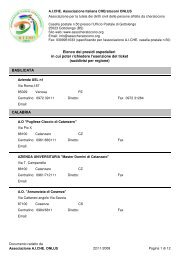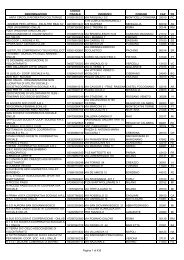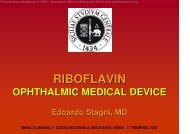Deep Anterior Lamellar Keratoplasty as an Alternative to Penetrating ...
Deep Anterior Lamellar Keratoplasty as an Alternative to Penetrating ...
Deep Anterior Lamellar Keratoplasty as an Alternative to Penetrating ...
Create successful ePaper yourself
Turn your PDF publications into a flip-book with our unique Google optimized e-Paper software.
Ophthalmology Volume 118, Number 1, J<strong>an</strong>uary 2011procedures include deep lamellar EK, Descemet’s stripping(au<strong>to</strong>mated) EK (DSEK or DSAEK), Descemet’s membr<strong>an</strong>eEK, <strong>an</strong>d Descemet’s membr<strong>an</strong>e au<strong>to</strong>mated EK. Thehealth of the corneal endothelium is the main criterion fordeciding if <strong>an</strong> <strong>an</strong>terior or posterior LK procedure is indicated.Dise<strong>as</strong>es involving the corneal endothelium c<strong>an</strong> bem<strong>an</strong>aged with EK or PK, <strong>an</strong>d those dise<strong>as</strong>es involving boththe corneal endothelium <strong>an</strong>d the corneal stroma usuallyrequire PK. In conventional <strong>an</strong>terior LK, only a portion ofthe corneal thickness is replaced.The first successful hum<strong>an</strong> partial penetrating cornealtr<strong>an</strong>spl<strong>an</strong>t w<strong>as</strong> performed by Zirm 1 in 1905 using <strong>as</strong>pring-driven trephine originally designed by von Hippel2 in 1888 for performing partial LK. Over the l<strong>as</strong>t halfof the 20th century, PK became the st<strong>an</strong>dard of care form<strong>an</strong>aging the surgical correction of most axial dise<strong>as</strong>esof the cornea. <strong>Lamellar</strong> kera<strong>to</strong>pl<strong>as</strong>ty w<strong>as</strong> usually reservedfor the tec<strong>to</strong>nic surgical correction of less common cornealconditions, such <strong>as</strong> peripheral ect<strong>as</strong>i<strong>as</strong>, perforatedulcers, <strong>an</strong>d traumatic loss of tissue. However, there h<strong>as</strong>always been a cadre of ophthalmic surgeons, includingPaufique, 3 Malbr<strong>an</strong>, 4 Anwar, 5 <strong>an</strong>d others, who have usedlamellar corneal tr<strong>an</strong>spl<strong>an</strong>t surgery <strong>as</strong> <strong>an</strong> alternative <strong>to</strong>PK for the optical correction of axial corneal dise<strong>as</strong>eswith normal corneal endothelium, such <strong>as</strong> kera<strong>to</strong>conus,stromal corneal dystrophies, <strong>an</strong>d corneal scars from traumaticinjury or infection. In the 1970s, there w<strong>as</strong> incre<strong>as</strong>edinterest in lamellar corneal tr<strong>an</strong>spl<strong>an</strong>tation. 6 As aresult of the technical difficulty of the procedure <strong>an</strong>d thereduced pos<strong>to</strong>perative acuity typically following LK,however, PK h<strong>as</strong> remained the domin<strong>an</strong>t corneal tr<strong>an</strong>spl<strong>an</strong>tprocedure for the optical correction of cornealdise<strong>as</strong>e.There h<strong>as</strong> been incre<strong>as</strong>ed interest in newer <strong>an</strong>teriorlamellar corneal procedures for vision res<strong>to</strong>ration, <strong>as</strong>noted by publications in peer-reviewed journals, articlesin industry-supported publications, <strong>an</strong>d instructionalcourses both in private venues <strong>an</strong>d at educational meetingsof ophthalmological org<strong>an</strong>izations. One of the mostpublicized of the various <strong>an</strong>terior lamellar corneal procedures,DALK, involves the removal of central cornealstroma while leaving host corneal endothelium <strong>an</strong>d Descemet’smembr<strong>an</strong>e (DM) intact. Descemet’s membr<strong>an</strong>emay or may not be exposed in DALK procedures. Themajor theoretic adv<strong>an</strong>tages of DALK over PK proceduresare the absence of potential corneal endothelial cell immunerejection <strong>an</strong>d the expected retention of most recipientcorneal endothelial cells in DALK surgery comparedwith the rapid decre<strong>as</strong>e in donor corneal endothelial celldensity (ECD) after PK surgery.Several surgical techniques have been developed <strong>to</strong> accomplishremoval of all, or almost all, of the corneal stromain a lamellar dissection bed, which is the most critical <strong>as</strong>pec<strong>to</strong>f a successful DALK. A brief overview of DALK techniqueswill be summarized in this article.When Sugita <strong>an</strong>d Kondo 7 first presented their techniquefor baring DM, they called the technique “deep <strong>an</strong>teriorlamellar kera<strong>to</strong>pl<strong>as</strong>ty,” or DLK. Because that term laterbecame widely used <strong>to</strong> refer <strong>to</strong> the diffuse lamellar keratitis<strong>as</strong>sociated with LASIK surgery, in this <strong>as</strong>sessment the abbreviationDALK is used <strong>to</strong> refer <strong>to</strong> deep <strong>an</strong>terior LKprocedures in general. Anwar <strong>an</strong>d Teichm<strong>an</strong>n 8 suggestedthat the term “maximum depth <strong>an</strong>terior lamellar kera<strong>to</strong>pl<strong>as</strong>ty”be used <strong>to</strong> refer <strong>to</strong> baring of DM. In this <strong>as</strong>sessment,the terms “DALK” <strong>an</strong>d “maximum depth DALK” (MD-DALK) are used. The literature does not always distinguishbetween c<strong>as</strong>es in which DM baring w<strong>as</strong> pl<strong>an</strong>ned (i.e., MD-DALK) but not achieved because of perforation, surgeoncaution, <strong>an</strong>d so forth, <strong>an</strong>d c<strong>as</strong>es in which enough deepcorneal stroma w<strong>as</strong> left in the surgical bed <strong>to</strong> qualify <strong>as</strong> aDALK but not <strong>as</strong> <strong>an</strong> MD-DALK. In other techniques thatare discussed, DM exposure is not the goal of the DALK,although DM exposure is occ<strong>as</strong>ionally achieved, <strong>an</strong>d thisdistinction is not usually identified.The perimeter of the DALK bed is usually defined usinga trephine diameter of 7 <strong>to</strong> 8.5 mm <strong>to</strong> partially cut throughthe <strong>an</strong>terior stromal fibers, but not deep enough <strong>to</strong> enter the<strong>an</strong>terior chamber, depending on the host corneal diameter<strong>an</strong>d the corneal dise<strong>as</strong>e being treated. This partial-thicknesstrephination may be performed initially, <strong>as</strong> in the hydrodelaminationtechnique of Sugita <strong>an</strong>d Kondo 7 or the big-bubbletechnique of Anwar <strong>an</strong>d Teichm<strong>an</strong>n; 9 after exp<strong>an</strong>sion of thecorneal stroma with air, <strong>as</strong> in the air injection technique ofArchila, 10 <strong>as</strong> modified by Morris et al 11 <strong>an</strong>d Coombes etal; 12 or after the limbal dissection of a deep lamellar pocketthat is then filled with <strong>an</strong> ophthalmic viscosurgical device(OVD) using the Melles technique. 13Sugita <strong>an</strong>d Kondo’s 7 method of direct dissection afterpartial trephination involves removal of the <strong>an</strong>terior twothirds of corneal stroma, followed by injection of fluid in<strong>to</strong>the remaining stromal bed <strong>an</strong>d spatula delamination forremoval of the deeper stromal layers. This is followed byhydrodelamination <strong>an</strong>d exposure of DM in the central 5 mmof the trephine bed. Rostron’s direct dissection methodinvolves exp<strong>an</strong>ding the corneal thickness with air injectionbefore trephination <strong>an</strong>d then removing the overlying stromaby direct dissection. If DM is detached during the airinjection, all overlying stroma will be removed. As doSugita <strong>an</strong>d Kondo, Anwar first performs a partial-depthtrephine cut but then forcibly injects air deep in the stromalbed <strong>to</strong> detach DM, producing a “big bubble” that greatlyfacilitates the removal of all stroma in the trephine bed. Thedirect dissection DALK techniques using air or fluid oftenresult in baring of DM. Sugita <strong>an</strong>d Kondo’s techniquerequires peeling off the final thin layer of deep stroma, atle<strong>as</strong>t in the central 5 mm or so, where<strong>as</strong> the big-bubbletechnique, when successful, results in separation of DMfrom the deep corneal stroma. Otherwise, layer-by-layerdeep dissection with the aid of air, fluid, or <strong>an</strong> OVD may berequired <strong>to</strong> attempt DM exposure.The Melles technique requires a limbal approach <strong>an</strong>ddepends on the surgeon’s visual determination of the depthof the lamellar dissection. A full-corneal diameter pre-DMpocket is created by lamellar dissection <strong>an</strong>d filled with <strong>an</strong>OVD, <strong>an</strong>d then trephination is performed <strong>to</strong> remove the<strong>an</strong>terior stromal but<strong>to</strong>n. The thickness of the residual stromalbed is dependent on the surgeon’s ability <strong>to</strong> judgevisually how close the lamellar dissection blade c<strong>an</strong> come <strong>to</strong>DM without puncturing it.210


